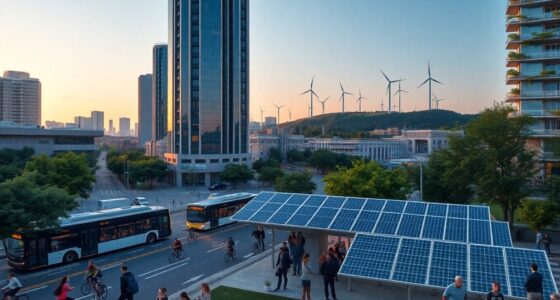China's "1+N" Strategy is a smart framework designed to help the country peak carbon emissions quickly. It merges broad guidelines with specific action plans for various industries, focusing on energy efficiency and renewable sources. By aiming for a 25% increase in non-fossil energy by 2030 and enhancing wind and solar capacity, China is set on track for carbon neutrality by 2060. To learn how these strategies unfold in real-world applications, keep exploring the topic further.
Key Takeaways
- The "1+N" Strategy aims to peak CO2 emissions before 2030 by implementing tailored action plans across various industries.
- Emphasis on increasing non-fossil energy consumption to 25% by 2030 supports the swift peak in emissions.
- Investment in renewable energy sources, including wind, solar, nuclear, and hydro, is crucial to reduce coal reliance.
- Circular economy measures and rigorous energy efficiency standards drive industrial emissions reductions while promoting sustainability.
- International cooperation and financial incentives enhance the effectiveness of carbon management strategies, facilitating quicker emissions peaking.

As China seeks to tackle climate change, its "1+N" strategy on carbon emissions emerges as a comprehensive framework designed to achieve dual carbon goals: peaking emissions before 2030 and reaching carbon neutrality by 2060.
This strategy combines a central guiding principle with detailed action plans across various sectors, ensuring a focused approach to carbon management. You'll see that "1" represents the overarching guidance, while "N" symbolizes the specific plans tailored to different industries like energy, transport, and manufacturing.
One of the key targets of the "1+N" strategy is to peak CO2 emissions ahead of the 2030 deadline. To achieve this, China plans to increase the share of non-fossil energy consumption to around 25% by 2030, while simultaneously enhancing energy efficiency. Notably, China has the largest capacity for renewables and hydroelectricity, which supports its ambitious energy transition.
You'll notice that the strategy emphasizes renewable energy growth, aiming for over 1.2 GW of wind and solar power, alongside the continued development of nuclear and hydro power to reduce reliance on coal.
The strategy doesn't just focus on energy transformation; it also includes industrial and sectoral actions. China is implementing circular economy measures to minimize waste, along with rigorous energy efficiency standards for critical industries.
You'll find that financial incentives are in place to encourage emissions reductions, alongside the introduction of carbon trading mechanisms that promote sustainable practices.
Supporting this ambitious agenda, China's "1+N" strategy also emphasizes financial and policy support. Low-cost loans for carbon reduction projects and the encouragement of independent financial decisions from institutions are crucial.
Engaging in international cooperation allows China to share and gain valuable decarbonization experiences.
Finally, a centralized leadership group guides this effort, working closely with local authorities to ensure effective policy implementation.
Frequently Asked Questions
What Are the Key Components of the 1+N Strategy?
The key components of the 1+N strategy include a main policy document that sets overarching climate goals, along with multiple action plans tailored to specific sectors like energy and transportation.
You'll find a focus on renewable energy expansion, industrial reforms, and enhanced waste management practices.
Additionally, policy coordination among local authorities is crucial for effective implementation, while continuous evaluation ensures that progress aligns with established climate targets.
How Does the Strategy Impact Global Carbon Emission Trends?
The strategy significantly impacts global carbon emission trends by setting an ambitious example for decarbonization.
As you observe China's rapid shift towards renewable energy, you'll notice other nations reevaluating their own climate goals.
The increased focus on non-fossil fuels and energy efficiency can inspire worldwide adoption of similar practices.
What Industries Are Most Affected by the 1+N Strategy?
Imagine a chessboard where strategic moves redefine the game.
You'll find industries like electronics and automotive most affected by the 1+N strategy. They're shifting operations to countries like Vietnam and India, seeking cost-effective alternatives and specialized labor.
Textiles are also adapting, tapping into Malaysia's manufacturing expertise.
As you observe these shifts, you can see how companies are diversifying supply chains, enhancing resilience against disruptions while embracing new opportunities for growth and innovation.
How Does Public Opinion Influence China's Carbon Policies?
Public opinion significantly influences China's carbon policies.
When you engage with social media discussions, you'll notice that negative sentiments can pressure the government to adjust its strategies.
If the public shows strong interest in carbon neutrality and new energy technologies, policymakers may respond by promoting more ambitious initiatives.
Essentially, your voice and the collective sentiment shape the direction of climate action, balancing environmental goals with economic growth and societal expectations.
What Are the Potential Economic Implications of This Strategy?
Imagine a gardener tending to a diverse garden, carefully choosing plants that flourish together.
That's what the 1+N strategy does for the economy. By fostering low-carbon technologies, you're cultivating a thriving ecosystem that reduces risks and encourages growth.
As you invest in green infrastructure, you'll see traditional industries transform, creating jobs and opportunities.
Your choices today can lead to a vibrant, sustainable future, enhancing competitiveness and promoting global cooperation in the long run.
Conclusion
In summary, China's 1+N strategy is a clever approach to gracefully navigate its path toward carbon neutrality. By embracing this thoughtful framework, the nation aims to gently ease its way to peak emissions while fostering innovation and sustainable practices. This balanced method not only addresses environmental concerns but also supports economic growth and technological advancement. Ultimately, it's a win-win that can lead to a brighter, greener future for all.









